15 Common Types of Sparrows in Missouri (With Pictures)
Last Updated on
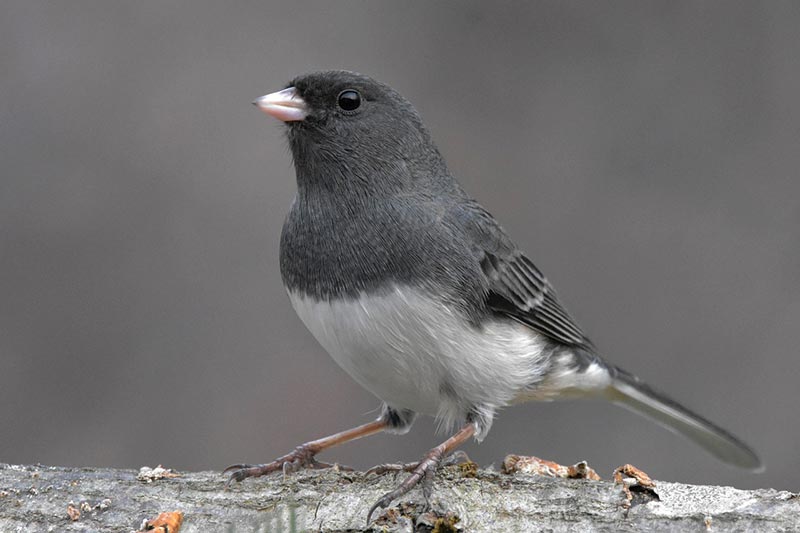
Sparrows are classified as typical “backward” domestic birds belonging to the Passeridae bird family. These birds are small, chiefly-seeding eating birds that have short bills. Overall, they are short in stature and have small round bodies.
However, these birds come in a variety of colors, and many are native to the United States. In this article, we are going to discuss some of the most common types of sparrows that you’ll find in the state of Missouri. Missouri is known for its moderate temperatures and large grassy terrains. It’s these factors that make it easy for sparrows to call the state their home.

The 15 Common Types of Sparrows in Missouri
1. Song Sparrow (Melospiza melodia)
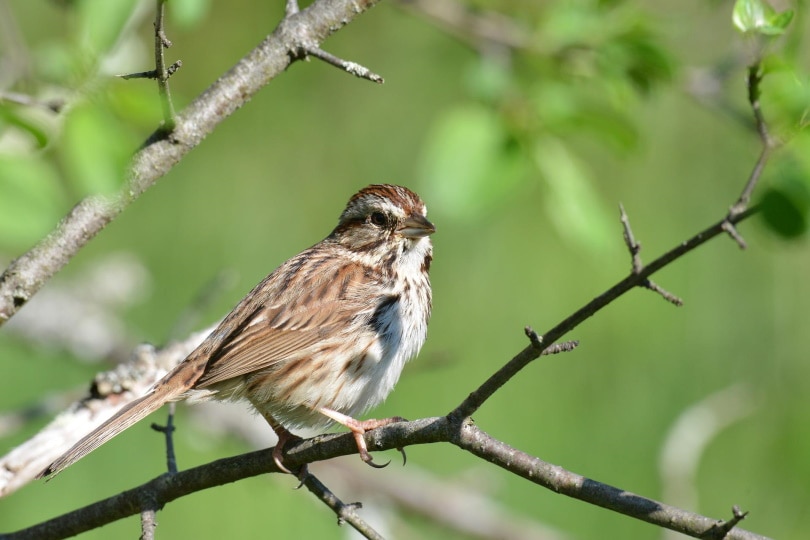
| Average Weight: | 0.5-1.8 oz. |
| Scientific Name: | Melospiza melodia |
Song Sparrows are small birds with grayish-brown feathers, covered in white spots and streaks. These birds are fairly short and have round white bellies and short legs. You will find them all over the state of Missouri around March through late July, which is their breeding season.
You can often find them at backyard feeders, and they’ll eat insects and plants including earthworms, caterpillars, earthworms, and beetles. And they also love seeds, grain (such as wheat), and fruit. You may hear them during the breeding season, as their mating calls consist of long trills and buzzing that’s pretty hard to miss.
2. Eastern Towhee (Pipilo erythrophthalmus)
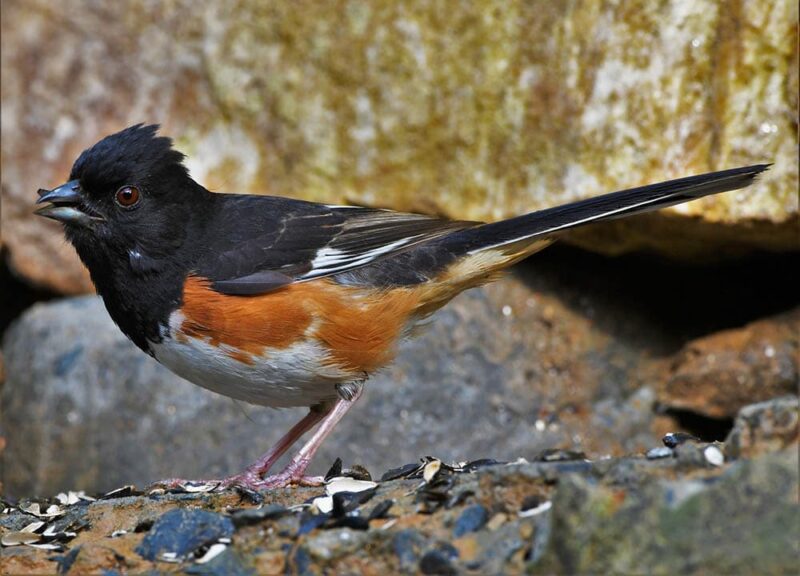
| Average Weight: | 1.1-1.9 oz. |
| Scientific Name: | Pipilo erythrophthalmus |
Eastern Towhees are also common to Missouri. These birds have black hood and back feathers, with white feathers on their bellies and tan feathers on their upper wings. However, the females are more brownish all over, while the males have more distinctive feather patterns.
They can be seen in the state and nearby midwestern states during their breeding season from April through late September. Eastern Towhees are found all year round in the southeastern United States. These small birds can be found in the undergrowth, along the edges of thickets and forests, or the ground, usually hidden by fallen leaves. For food, they prefer grain, seeds, and fruit.
3. Savannah Sparrow (Passerculus sandwichensis)
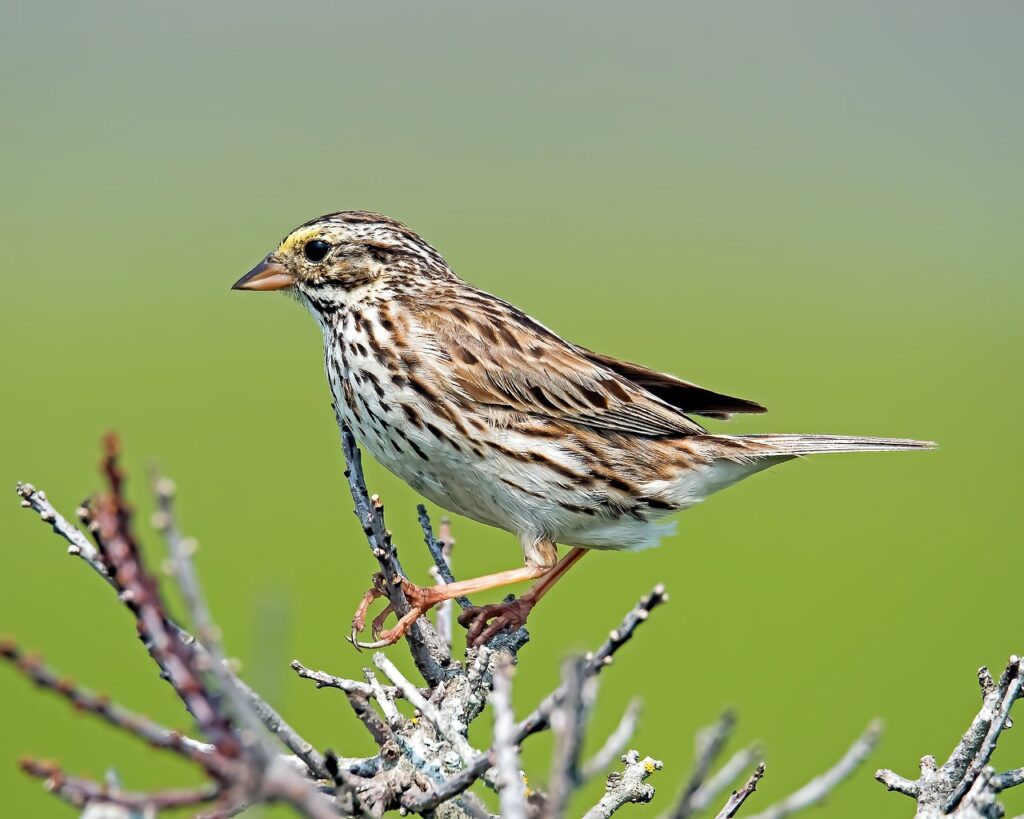
| Average Weight: | 0.6-1.1 oz. |
| Scientific Name: | Passerculus sandwichensis |
Savannah Sparrows are easy to spot due to their dotted feather patterns. These brown birds are often spotted from March through July, though many are still present in the state all year round. Savannah Sparrows have short tails, streaky-dotted brown coloring and a yellow spot right at the top of their eyes.
Savannah Sparrows are characterized by a yellow spot at their eye. Savannah Sparrows can be found on the ground in grassland and open areas in winter, searching for seeds and insects in the breeding season. These birds are native to Canada and the US, and then migrate to the southern US for winter. These sparrows prefer insects and seeds for food.
4. Chipping Sparrow (Spizella passerina)
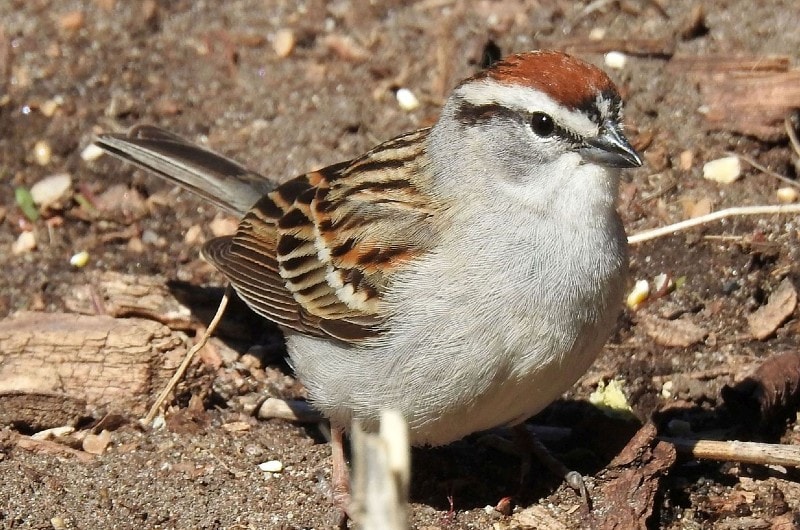
| Average Weight: | 0.4-0.7 oz. |
| Scientific Name: | Spizella passerina |
Chipping Sparrows are short, stocky, and have round bellies with short pink legs. Their feathers are brown streaked with a rusty crown, and they have a brown patch of fur on their hood. Chipping sparrow nests are found off the ground in trees and shrubs — all of which are constructed by females.
Although the nests are made of small roots and dried grass, they are not dense and very basic. They get their name from their distinctive song which has a sharp chipping tone. For food, these sparrows prefer seeds, fruit, suet, or grain.
5. Field Sparrow (Spizella pusilla)
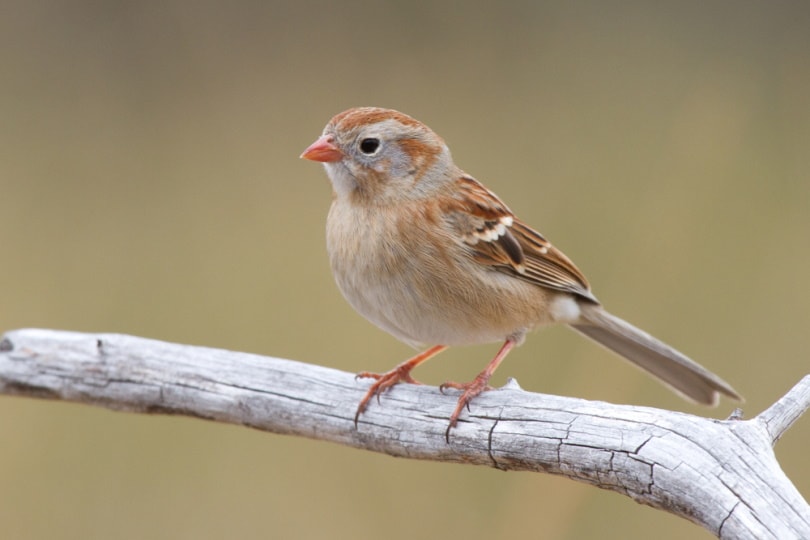
| Average Weight: | 0.4-0.6 oz. |
| Scientific Name: | Spizella pusilla |
Field Sparrows look like many other sparrows in appearance. They’re short with round white bellies and spotted gray-brownish feathers on their back and heads. They can be found in Missouri anywhere from April through November and will migrate south for the winter.
They can be found perched on top of small shrubs or entry cavities and their nests are usually made of grass and small twigs. They love hanging out and abandon the field and for food, they prefer seeds, millet, corn, and grains. To attract them, you can simply add a feeder to your yard with their favorite foods and look for them in the early morning hours.
6. Vesper Sparrow (Pooecetes gramineus)

| Average Weight: | 0.6-1.0 oz. |
| Scientific Name: | Pooecetes gramineus |
Vesper Sparrows may not be as popular in the area as other sparrow varieties, but you may Natalie catch them during their breeding season which is around late April through early October. They have brownish-gray feathers with a white underbelly and short pink legs.
These small birds are stout with round bellies, and you can find them on the ground foraging in open fields, meadows, and areas with tall grass. They usually spend their summers breeding in the northern US and Canada and then they migrate to Mexico and the south for winter. For food, they’ll partake in wild seeds of grasses, weeds, and some small insects.
7. House Sparrow (Passer domesticus)
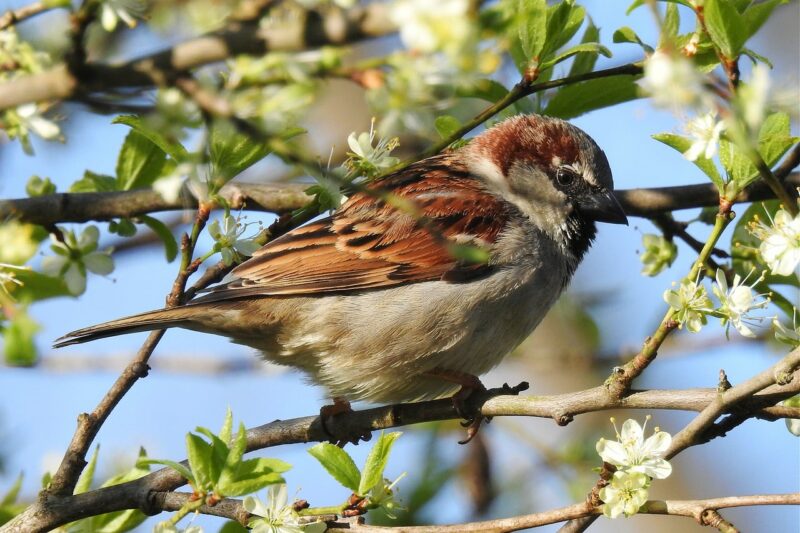
| Average Weight: | 0.8 -1.0 oz. |
| Scientific Name: | Passer domesticus |
You’ve probably seen a house sparrow on your way home from work and they’re often spotted near buildings and houses. Their heads are grayish brown with white cheeks and their beaks are black.
Their bellies and backs are grayish, while their back feathers are black and brown. House Sparrows consume a lot of grain and seed, as well as discarded food. For this reason, they are often found in backyards and in urban areas. But they are not migratory, and they can be found all year in the US, Mexico, and Canada.
8. Henslow’s Sparrow (Centronyx henslowii)

| Average Weight: | 0.4-0.6 oz. |
| Scientific Name: | Centronyx henslowii |
Henslow’s Sparrows can be found perched on shrubs and hanging out in tree cavities–especially from early April to September, which is their breeding season. Their faces are almost greenish brown with distinct black stripes. They also have pale chests with white streaking and their belly is white.
They’re able to hide easily in their natural environment and it can be difficult to distinguish between males from females. These sparrows are native to the northeastern US and migrate to the south for winter.
You can find these small birds in dense, wet grasslands or on abandoned farms with tall patches of grass. These secretive birds prefer to forage at the base of grass stalks, munching on seeds, berries, and insects.
9. Grasshopper Sparrow (Ammodramus savannarum)
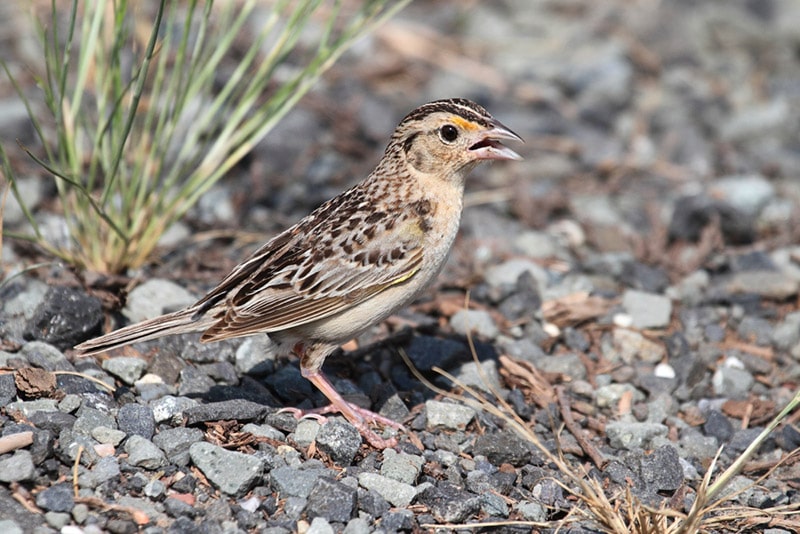
| Average Weight: | 0.45-0.7 oz. |
| Scientific Name: | Ammodramus savannarum |
Grasshopper Sparrows are seen in Missouri from April through late August, when they are in the breeding season. These small, tiny birds have light brown streaking and a distinct orange or yellow stripe over their eyes.
Like other sparrows, they’re short birds with short tails and large round bellies. Grasshopper Sparrows can be found on grassland, prairies, or in other open areas searching for grasshoppers. These birds spend the winter in the southeastern US, the Caribbean, or Mexico. They love snacking on seeds and berries but eat mostly fallen seeds in winter.
10. Dark-eyed Junco (Junco hyemalis)
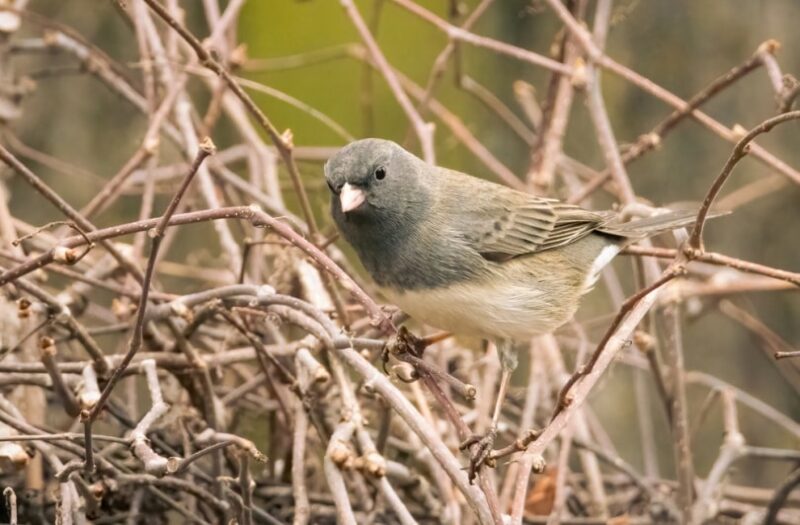
| Average Weight: | 0.5-1.1 oz. |
| Scientific Name: | Junco hyemalis |
Dark-eyed Juncos stand out from other sparrows due to their solid feather pattern. They are usually slate-colored or black, white, brown, and gray. You can find these birds in Missouri, other midwestern states, and the Appalachian Mountains all throughout the year. They can be found in both partially and open areas.
These birds are primarily seed eaters, but they’ll also eat small insects such as spiders, worms, and caterpillars. Dark-eyed Juncos often hang out on the ground, making nests inside of shrubs that are lined with grass and hair.
11. American Tree Sparrow (Spizelloides arborea)

| Average Weight: | 0.5-1.0 oz. |
| Scientific Name: | Spizelloides arborea |
American Tree Sparrows are a bit bigger than many other sparrow varieties. You can usually spot these birds in Missouri in the late fall to early summer months. These winter sparrows are long-tailed, brown-streaked, plump birds with gray heads and have rust-colored caps.
They also have rust-colored stripes on the backs of their wings. Overall, they have grayish-brown feathers and light-whitish bellies. They migrate to the US for the winter and are usually found in Alaska and Canada.
These birds can be found foraging in small groups in weedy fields or under bird feeders. Or you may also come across their nests, which are often found on or near the ground and made from grass, moss, and branches. These sparrows love sunflower seeds, small insects, and grain.
12. White-throated Sparrow ( Zonotrichia albicollis)

| Average Weight: | 0.7-1.2 oz. |
| Scientific Name: | Zonotrichia albicollis |
White-throated Sparrows stand out due to the pale-yellow patches of fur on top of their eyes. But other than that, they pretty much have the same build and feather pattern as other sparrows. They’re short, stout, and grayish brown with round white bellies.
These sparrows have a black and white striped head and bright white throat. They can be spotted most often in Missouri between late September and October and early June. These sparrows migrate from Canada to the Pacific Coast and can be found on the ground in wooded areas and forests, and often in large groups. These small birds prefer to eat seeds of grasses, fruit, and weeds. In summer, they will also eat non-flying insects as well.
13. White-crowned Sparrow (Zonotrichia leucophrys)

| Average Weight: | 0.9-1.0 oz. |
| Scientific Name: | Zonotrichia leucophrys |
White-crowned Sparrows are winter birds that can be found around Missouri and neighboring states, especially during migration seasons in late April and early October. Illinois in winter. These sparrows can be described as large, grayish sparrows that have long tails and small bills.
They also have bold black and white stripes on the top of their heads. These round sparrows are typically found in Alaska and arctic Canada, and then travel south (and to Mexico) for colder months.
They can often be found in weedy areas, along roadsides and forest edges or foraging in grasslands looking for seeds of weeds or berries such as elderberries and blackberries. White-crowned Sparrow sounds are often short and sharp.
14. Fox Sparrow (Passerella iliaca)

| Average Weight: | 0.8-1.7 oz. |
| Scientific Name: | Passerella iliaca |
Fox Sparrows are short with spotted white and brown bellies and brown-reddish hoods. These larger sparrows can be seen in Missouri from late August to late June. This sparrow is quite large in comparison to other birds in the same family and they are usually seen in the eastern regions of the state as well as in California, Alaska, and other western states.
They do migrate to southern states in the winter and prefer to hang out in dense shrubs, and wooded areas. You may also catch these large birds kicking up leaf litter to find food, as they typically feast on small insects, berries, grasses, and seeds.
15. Swamp Sparrow (Melospiza georgiana)
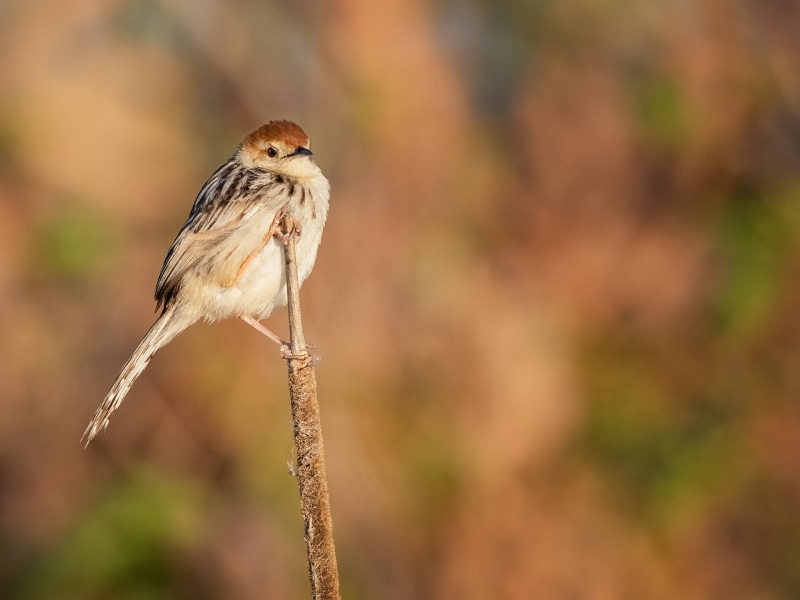
| Average Weight: | 0.4-0.9 oz. |
| Scientific Name: | Melospiza georgiana |
Swamp Sparrows are mostly seen in the late months of the year, though you may also catch them in early spring before migration. These sparrows look similar to other native sparrows and have dark brown backs with rusty and black wings.
They have white throats and heads with gray breasts. They also have distinctive yellow patches of feathers right above their eye above their beak. These sparrows are also native to Canada and northern states, though they migrate south for the winter.
And as their name suggests you can find them hanging around bogs, swamps, and coastal marshes. For their diet, swamp sparrows prefer seeds and fruit, but will eat small insects in the warmer months.

Wrapping Things Up
As you can see, there are several sparrow species that can be seen all around the state of Missouri. You can catch many of these birds in between breeding seasons or at the start of spring. Hopefully, this list will help you be able to identify them easier.
Featured Image Credit: JackBulmer, Pixabay
Table of Contents
- The 15 Common Types of Sparrows in Missouri
- 1. Song Sparrow (Melospiza melodia)
- 2. Eastern Towhee (Pipilo erythrophthalmus)
- 3. Savannah Sparrow (Passerculus sandwichensis)
- 4. Chipping Sparrow (Spizella passerina)
- 5. Field Sparrow (Spizella pusilla)
- 6. Vesper Sparrow (Pooecetes gramineus)
- 7. House Sparrow (Passer domesticus)
- 8. Henslow’s Sparrow (Centronyx henslowii)
- 9. Grasshopper Sparrow (Ammodramus savannarum)
- 10. Dark-eyed Junco (Junco hyemalis)
- 11. American Tree Sparrow (Spizelloides arborea)
- 12. White-throated Sparrow ( Zonotrichia albicollis)
- 13. White-crowned Sparrow (Zonotrichia leucophrys)
- 14. Fox Sparrow (Passerella iliaca)
- 15. Swamp Sparrow (Melospiza georgiana)
- Wrapping Things Up
About the Author Robert Sparks
Robert’s obsession with all things optical started early in life, when his optician father would bring home prototypes for Robert to play with. Nowadays, Robert is dedicated to helping others find the right optics for their needs. His hobbies include astronomy, astrophysics, and model building. Originally from Newark, NJ, he resides in Santa Fe, New Mexico, where the nighttime skies are filled with glittering stars.
Related Articles:
Monocular vs Telescope: Differences Explained (With Pictures)
10 Types of Hummingbirds in Arkansas (With Pictures)
8 Types of Hummingbirds in Nebraska (With Pictures)
5 Types of Hummingbirds in Idaho (With Pictures)
3 Types of Hummingbirds in Mississippi (With Pictures)
8 Types of Hummingbirds in Kansas (With Pictures)
5 Types of Hummingbirds in West Virginia (With Pictures)
5 Types of Hummingbirds in Ohio (With Pictures)
